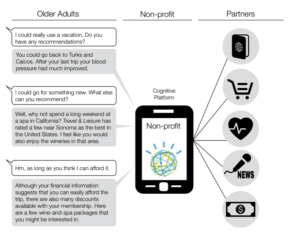Every Monday, we recap the mature marketing content that most engaged during the previous week.
This week, an article published on Senior Housing News details the importance of collaboration between providers in the senior living industry as well as a new vision for developing solutions for the challenges that accompany aging.
In addition, an article published by the Sydney Morning Herald confirms that older adults are still having to combat ageism in the workplace on a large scale.
MOST CLICKED: IBM Lays out “New Vision” for Senior Care Tech
IBM recently collaborated with the Consumer Technology Association Foundation to publish a report called “Outthink Aging” in which they detail some of the current issues with the senior living technology industry, their solutions for combating these issues and their new vision for senior care.
One of the key issues highlighted in the report was what they defined as a disconnect between the personal and provider ecosystems within the senior living industry.
The personal ecosystem includes senior living residents and prospects, as well as their family caregivers, friends, community connections, etc., while the provider ecosystem consists of the senior living and nursing home industries, insurance groups, financial services providers and more.
Within the provider ecosystem, the report identified a lack of communication and integration between the various provider groups. As a result, they noted that these groups are not meeting their full potential in regards to meeting aging needs, with members of the personal ecosystem are suffering as a result.
Through their eight-week Outthink Aging Innovation Olympics program that began in February 2016, IBM and partner organizations sought to solve real innovation and growth issues within the senior living industry and provided some key recommendations for providers as a result of the study.
- Provide knowledge as a service: A central information system containing industry data and public information could only benefit providers and their partner agencies.

For marketing professionals in the senior living industry, it would provide access to vital information for targeting prospects, and more importantly, developing individualized solutions for based on the needs of each unique prospect.
2. Create cognitively powered communities: As Creating Results’ Social, Silver Surfers study has pointed out, more older adults are relying on digital platforms to research information on CCRCs and other senior services.
Senior living residents and prospects don’t want to feel isolated, and providing a medium for them to communicate via virtual town squares allows them to stay connected and share information with one another.
If your community doesn’t have a digital platform in which residents and prospective residents can communicate with one another, you are missing valuable feedback on ways to improve your services from the people who actually use them.
3. Protect older adults from financial fraud: Asset protection is one of the key concerns for seniors.
As such, an important way of differentiating your community from others is to embrace the spirit of collaboration that the “Outtthink Aging” report calls for and ensure that you are partnered with organizations that specialize in asset protection for seniors.
Click here to read the article in its entirety.
MOST SHARED: Companies that Use Older Workers are the Most Innovative
An article published by the Sydney Morning Herald confirms that society is still struggling with ageism in the workplace, both in the United States and numerous countries across the globe.
According to the article, companies tend to think that older adults, even those as young as 45, don’t understand the latest technology or have ideas that will carry them into the future.
A soon-to-be published study conducted by Associate Professor Leanne Cutcher from the University of Sydney Business School has found that companies where employee age doesn’t matter tend to be more innovative than companies with age policies.
More diverse ideas are being shared due to varying levels of experience, and it is paying dividends for the businesses that embrace having older employees, as well as young ones.
The important takeaway in all this is to remember that adults that are 50+ still want to contribute to society, especially in the workplace.
For senior living communities, it is important to remember that not every resident is ready to give up working and learning just yet.
If your community doesn’t already provide opportunities in which residents can engage in the workforce or continue their education through lifelong learning programs, then it is time to start partnering with organizations that can make that a reality for members of your community.
Age should not be the deterrent that many companies make it out to be. The research shows that 75% of baby boomers adapt well to new technology, while a further 73% are actively seeking new training opportunities.
For example, many communities, such as our client North Hill, organize classes in which they give residents an overview of how to use an iPad. These classes are almost always filled to capacity because seniors want to learn how use these new technologies.
Australian Senior Insurance Agency spokesman Simon Howell put it best when he said, “The findings point to what many organizations, academics and economists have known all along — baby boomers are a real asset to the workplace.”


